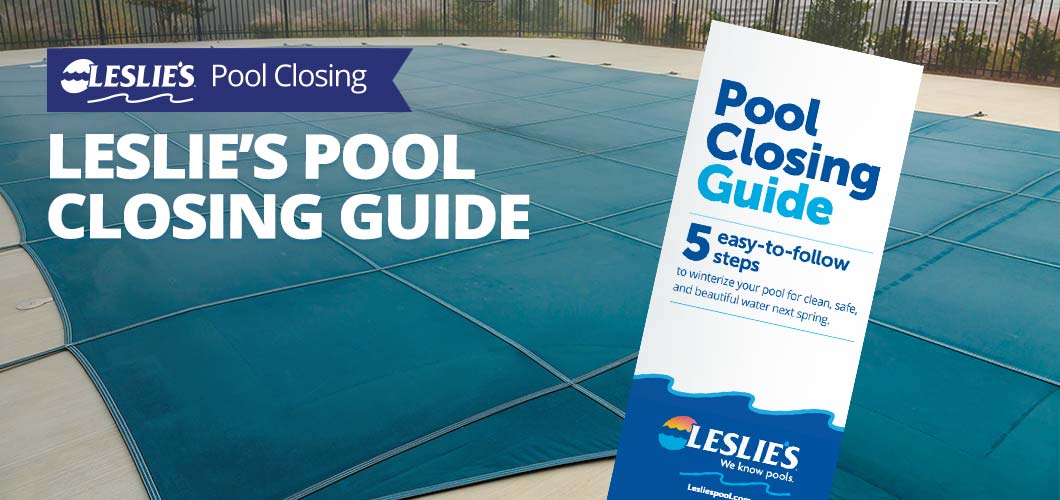
Leslie's Pool Closing Guide
At Leslie’s, we understand the importance of proper pool maintenance, even during the off-season. From water balance to freeze protection, we're here to help. In this post, we’ll discuss the steps to prepare your pool for closing, and we'll teach you how to properly winterize your pool to protect it from freezing temperatures and water issues. Failure to properly winterize your pool can result in stains, scaling, and equipment damage, all of which can be costly to correct.
Remember to not close your pool too early. Pool water needs to be consistently below 65ºF before closing for the winter. Closing too soon can cause the sanitizer to be used up too quickly, which can increase the risk of algae growth. This may cause more work, extra hassle, and additional expense when opening the pool back up in the spring.
CLICK HERE to download Leslie's FREE Pool Closing Guide and Checklist
Pool Closing Checklist
To make things easier, we’ve put together a quick checklist with the proper steps on how to winterize a pool. Before you get started, gather the following essential items needed to close a pool:
Inground Pools
- Pool Closing Kit or winter chemicals
- Safety cover or winter cover
- Leaf net (optional)
- Swimming pool antifreeze (1 gallon per 10 feet of pipe)
- Water bags or winter cover blocks
- Skimguard winterizer (1 per skimmer required)
- Submersible pump
- Pipe blowout device, such as a liner vac, air compressor, or wet/dry vac (blowout extension or plugs required)
- Winterizing freeze plugs (1 per return fitting)
Above Ground Pools
- Pool Closing Kit or winter chemicals
- Winter cover
- Leaf net (optional)
- Air pillow(s)
- Cable and winch assembly
- Water bags, cover clips, or winter wrap (optional)
- Pillow Pal
- Skimmer plugs
- Submersible pump

How to Close a Swimming Pool
STEP 1: Clean and Balance

- Brush, skim, and vacuum the pool to remove all dirt, leaves, and debris. Don’t leave anything behind for bacteria or algae to eat.
- If using a Pool Closing Kit, follow the instructions for the included chemicals.
- Test the water to make sure your water balance is in the recommended ranges. Leslie's can help with a free in-store AccuBlue water test.
- Free Available Chlorine: 2.0–4.0 ppm
- Total Alkalinity: 80–120 ppm
- pH: 7.4–7.6 ppm
- Calcium Hardness: 200–400 ppm
- Let your pool pump complete one full cycle after adding your chemicals, or about 4–12 hours depending on your pump size and pool volume. Then backwash or manually clean the pool filter before you close the pool.
- Using a submersible pump, lower the water about 4-6 inches below the skimmer inlet or tile line, whichever is lower. Do this only if the plumbing is properly configured to blow out the lines with an air compressor or the exhaust from a wet/dry vac. Alternatively, you can lower the water level below the skimmer and all return lines (normally about 18 inches below the tile line), which will allow the water to drain out of the returns. Never drain a vinyl or fiberglass pool — always refer to the manufacturer's instructions for winter draining procedures.
STEP 2: Winterize Plumbing (Freezing Climates Only)

- Turn off the main power supply and remove the “on” and “off” trippers from the time clock (if applicable).
- Remove the drain plugs from the pump strainer basket housing, pump volute (if applicable), filter tank, booster pump, automatic chlorinator, heater, and any other equipment. Place all the drain plugs in the strainer basket of the pump and replace the strainer cover.
- Position the multiport valve handle (if applicable) between any two settings. Some multiport valves have a dedicated "Winter" setting for pool closing purposes.
- For above ground pools, disconnect the filter hoses from the skimmer fitting and from the pool return fitting, and move the equipment to a non-freezing location, such as a basement.
- When the water has completely drained out of the plumbing lines, put winterizing plugs into the return and skimmer line(s).
- Add non-toxic swimming pool antifreeze (DO NOT use automotive antifreeze) to all lines, and place a Skimguard or Gizzmo winterizer into the skimmer to take up any expansion due to freezing. The Skimguard will also seal off the skimmer line and trap any air in the line. If the skimmer is connected to the main drain, this air lock will prevent water from rising in the plumbing line when adding water to the pool.
- Refill the pool to 4–6 inches below the skimmer inlet in vinyl liner pools, or 4–6 inches below the tile line in gunite and plaster pools. This will prevent ice damage to the tile.
PRO TIP: In moderate freezing climates, a freeze protector is an option. Freeze protectors trigger the equipment to run at certain low temperatures, assuring water flow and preventing equipment, plumbing, and valve damage from freeze expansion.

STEP 3: Prepare Deck and Surrounding Area
- Remove all ladders, hoses, pool cleaners, and over-the-top skimmers. Drain the cleaner, and lay any hoses out straight in a non-freezing location, such as a basement or garage.
- If the coping or deck around your pool has a rough surface or edge, protect your pool cover by placing foam, old solar cover material, or other soft material around the perimeter of the pool. This will help prevent premature wear.
- For above ground pools, inflate the air pillow and tie to an anchor with rope. As an alternative, you can use the Pillow Pal to attach the air pillow to the bottom of your winter cover. If you need multiple air pillows, tie them together using the grommets at the corners. Air pillows help relieve the pressure of expanding ice, support the cover, and make water removal from the cover easier to accomplish.
STEP 4: Size Your Pool Cover

- Take measurements of your pool and write them down prior to pool closing. Although this step is fourth on the list, don't wait until the last minute to order your cover.
- Above ground pools:
- Usually the standard cover for your pool size will provide enough coverage for an above ground pool, and include overlap to compensate for the air pillows and distance between the water and top ledge of the pool.
- If you are in a hard freeze area, or intend to lower the water more than 12", add 2' to each measurement to ensure proper coverage.
- Avoid “tenting” of the cover by ensuring the cover lays flat against the pool walls and water surface. If the cover is stretched and “tented”, damage will occur when rain or snow accumulate, stressing the cover.
- Inground pools:
- When covering an inground pool for the winter, the standard cover for your pool size will usually suffice, as it includes overlap for the water bags to sit on.
- If your steps extend further than the length of the pool, purchase the next larger size. For example, a 16' x 32' pool with steps that extend further than 32', the next larger cover size would be needed.
- If you are in a hard freeze area or intend to lower the water level any more than 12" below the skimmer or tile line, add 2' to each measurement to ensure proper coverage.
- Make sure the cover does not “tent.” This condition is where the cover is not lying flat against the sides of the pool and water surface, but rather pulled away from the wall at an angle. If the cover is “tented,” then as rain or snow fall on the cover, it will gradually pull the water bags into the pool or rip the cover.
STEP 5: Cover Your Pool

- Carefully unfold the cover and pull it across the pool.
- Ensure the winter cover is centered.
- For above ground pools, run a cable through all of the grommets and tighten until snug. Don't hang weights on the grommets, as this can stress the cover and eventually cause a tear. If wind is a problem, use small water bags on the surface of the pool to help weigh down the cover.
- For inground pools, use the grommets or straps to secure the water bags, water tubes, or cover blocks to your winter cover. Or, if using a safety cover, secure the cover to the deck anchors. Make sure to follow the manufacturer's instructions for best results in sealing your pool with the winter or safety cover.
- Place a water siphon or pool cover pump on the cover to drain rainwater, melted snow, or other precipitation from the cover. You may also opt to use a small submersible pump instead.
- We recommend checking the chemical balance about once a month after pool closing, and remember to remove all excess water and debris from the cover to keep it from getting bogged down.
PRO TIP: Why cover the pool? Using a pool cover helps keep leaves and debris out of the pool, which can make spring opening much easier. Even in areas where freezing isn't a problem, and you don't winterize the plumbing, a pool cover is an economical, low-hassle way to maintain your pool during the off-season. Aside from keeping out debris, they can also help reduce chemical and electrical expenses by at least 50% and minimize routine pool maintenance procedures.
Need Help? Ask Leslie's!
This helpful Pool Closing Guide can help you close your pool on your own. But if you'd prefer to have a Leslie's pool service professional do it for you, we're happy to help! Our service technicians are available to help you winterize your plumbing and close the pool. Service is not available in all areas, but you can stop by your local Leslie's or fill out the convenient online scheduling form for more information.